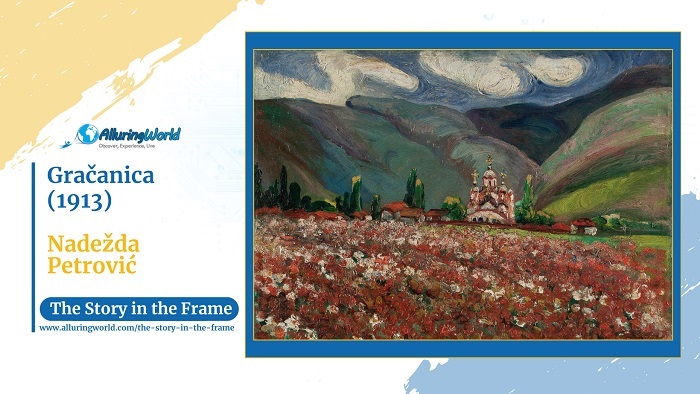Painted in 1913, Gračanica by Nadežda Petrović is a powerful and expressive depiction of the famous Gračanica Monastery located in Kosovo and Metohija, within the southwestern part of Serbia. As one of the most important works in Serbian modernist painting, this piece captures not only the physical beauty of the medieval Orthodox monastery but also its deep cultural and historical significance, and through her bold brushwork and vibrant color palette, Petrović transforms the monastery into a symbol of national identity, spirituality, and resilience.
About the Painter:
Nadežda Petrović (1873–1915) was a pioneering Serbian modernist painter and one of the most significant figures in Balkan art. She studied in Munich and was heavily influenced by Impressionism and Expressionism, yet she developed her own distinctive style, characterized by intense colors, thick impasto, and dynamic compositions. Her work often reflected themes of Serbian national heritage, war, and social struggle, and in addition to being a painter, she was also a dedicated humanitarian, volunteering as a nurse during the Balkan Wars and World War I, which tragically led to her early death from typhus in 1915.
Inspiration and Reasons Behind the Painting:
Petrović was deeply inspired by Serbian cultural and historical landmarks, often painting monasteries and landscapes that held national significance. Gračanica Monastery, which is a 14th-century Serbian Orthodox church, was not only an architectural masterpiece but also a symbol of Serbian heritage and Orthodox faith, particularly in the turbulent political climate of the early 20th century. At the time Gračanica was painted, Serbia was engaged in the Balkan Wars, and Petrović’s work reflects both admiration for the monastery and an underlying sense of national struggle and resilience.
What is Depicted in the Painting:
The painting presents a striking view of Gračanica Monastery, surrounded by a vibrant and expressive landscape. The structure itself, with its domes and arches, dominates the canvas, rendered in thick, energetic brushstrokes that highlight its architectural grandeur. The sky above and the surrounding land seem almost in motion, infused with dramatic color contrasts that give the scene an emotional intensity. Unlike traditional, highly detailed depictions of religious monuments, Petrović’s Gračanica focuses on the raw energy and spirit of the place rather than on precise realism.
Colors and Techniques:
Petrović’s use of color in Gračanica is bold and unconventional, featuring strong reds, purples, yellows, and blues that intensify the emotional impact of the scene. The thick application of paint (impasto) gives the painting a textured, almost sculptural quality, making the monastery feel alive within its setting, while the expressive brushwork and color choices align with early Expressionist tendencies, showcasing Petrović’s ability to merge traditional subject matter with modernist experimentation. The result is a painting that feels both deeply personal and universally powerful.
Conclusion:
Overall, Gračanica is more than just a depiction of a historic monastery—it is a statement on Serbian cultural identity, faith, and endurance during a time of great national upheaval. Petrović’s vibrant and expressive style breathes new life into the subject, making it one of the most remarkable examples of Serbian modernist painting. Her fearless approach to color and form continues to inspire generations of artists, cementing her legacy as a trailblazer in Balkan art.

